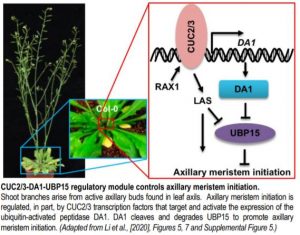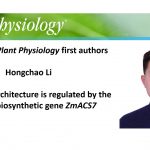Activate, Breakdown, Branch Out: CUC2/3-DA1-UBP15 Controls Axillary Meristem Initiation
Shoot architecture is a key ecological and agricultural trait that impacts biomass, the potential to harvest light, planting density, and the reproductive success of a plant. Branching is a prominent feature of plant shoot architecture. A shoot branch develops from an axillary bud, which is located in the axil of a leaf, i.e., between the leaf and primary shoot axis (Bennett and Leyser, 2006), and develops from an axillary meristem. Thus, shoot branching reflects the establishment and developmental potential of an axillary meristem. In a new study, Li et al. (2020) demonstrate that initiation of the axillary meristem is controlled by a regulatory module comprised of the transcription factors CUP-SHAPED COTYLEDONS2 (CUC2)/CUC3, the ubiquitin-activated peptidase DA1 and UBIQUITIN-SPECIFIC PROTEASE15 (UBP15).
 Previously, the DA1 gene (da meaning large in Chinese) was shown to regulate the size of lateral organs and seeds (Li et al., 2008). Li et al. (2020) also had noticed that the da1-1 mutant produced fewer vegetative branches, an observation supported here through the quantification of axillary buds. The authors showed that DA1 functions to initiate shoot axillary meristems using scanning electron microscopy and GUS reporter assays for the promoters of DA1 and the shoot apical and axillary meristem marker SHOOT MERISTEMLESS (STM). In the da1-1 mutant, where an axillary meristem fails to initiate, the STM promoter driving GUS expression of could not be detected in the axils of leaves. These results led Li and coworkers to investigate genetic interactions between da1-1 mutants and mutants that fail to initiate axillary meristems.
Previously, the DA1 gene (da meaning large in Chinese) was shown to regulate the size of lateral organs and seeds (Li et al., 2008). Li et al. (2020) also had noticed that the da1-1 mutant produced fewer vegetative branches, an observation supported here through the quantification of axillary buds. The authors showed that DA1 functions to initiate shoot axillary meristems using scanning electron microscopy and GUS reporter assays for the promoters of DA1 and the shoot apical and axillary meristem marker SHOOT MERISTEMLESS (STM). In the da1-1 mutant, where an axillary meristem fails to initiate, the STM promoter driving GUS expression of could not be detected in the axils of leaves. These results led Li and coworkers to investigate genetic interactions between da1-1 mutants and mutants that fail to initiate axillary meristems.
Arabidopsis CUC2 and CUC3 genes encode NAC domain transcription factors and are crucial regulators of organ boundaries and the establishment of axillary meristems (Hibara et al., 2006). To understand the genetic relationship between DA1 and CUC2/3, da1-1 cuc2 and da1-1 cuc3 double mutants were scored for axillary buds. da1-1 cuc2 resembled da1-1 for total axillary buds and da1-1 cuc3 resembled cuc3. These observations indicated that a common DA1-CUC2/3 genetic pathway regulates the inception of axillary meristems, a conclusion supported further by the finding that overexpression of DA1 increases axillary buds in cuc2/3 mutants. Building mechanism into their story, Li et al. (2020) identified core NAC binding sequences in the DA1 promoter and demonstrated that CUC2/3 proteins interacted with these binding sequences. Furthermore, inducible CUC2/3 transgenic lines showed that DA1 expression was under the control of CUC2/3.
With a powerful genetic screen in hand, Li et al. (2020) went hunting for genetic suppressors of the reduced axillary buds conditioned by mutations in DA1. One suppressor allele, sdb1-1, restored axillary buds in the da1-1 mutant to near wild-type levels. Mapping the underlying mutation in sdb1-1 uncovered a gene that encodes UBP15, a DA1 degradation target characterized previously by the authors. Overexpression of UBP15 decreased axillary bud number in independent transgenic lines, and similar to the da1-1 mutant, the GUS reporter driven by the STM promoter could not be detected in the axils of leaves of these transgenic plants. Because DA1 is a direct target of CUC2/3, and UBP15 is cleaved by DA1 peptidase activity, the authors hypothesized that increased UBP15 activity underlies part of the cuc2/3 phenotype. Indeed, upb15 suppressed the cuc2/3 phenotype with respect to the number of axillary buds. Li et al. (2020) summarized their results in a working model (see Figure), which proposes a CUC2/3-DA1-UBP15 regulatory module that functions to promote axillary meristem development in the leaf axil. An axillary meristem then gives rise to an axillary bud that can either continue developing as a vegetative branch or become dormant, thereby impacting overall shoot architecture.
Josh Strable
Plant Biology Section, School of Integrative Plant Science
Cornell University
ORCID: 0000-0002-0260-8285
REFERENCES
Bennett, T., and Leyser, O. (2006). Something on the side: axillary meristems and plant development. Plant Mol. Biol. 60: 843-854.
Hibara, K., Karim, M.R., Takada, S., Taoka, K., Furutani, M., Aida, M., and Tasaka, M. (2006). Arabidopsis CUP-SHAPED COTYLEDONS3 regulates postembryonic shoot meristem and organ boundary formation. Plant Cell 18: 2946-2957.
Li Y., Xia T., Gao F., and Li., Y (2020). Control of plant branching by the CUC2/3-DA1-UBP15 regulatory module in Arabidopsis. Published March 2020, DOI: https://doi.org/10.1105/tpc.20.00012
Li, Y., Zheng, L., Corke, F., Smith, C., and Bevan, M.W. (2008). Control of final seed and organ size by the DA1 gene family in Arabidopsis thaliana. Genes Dev. 22: 1331-1336.



